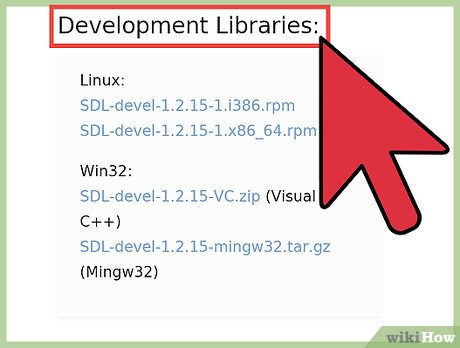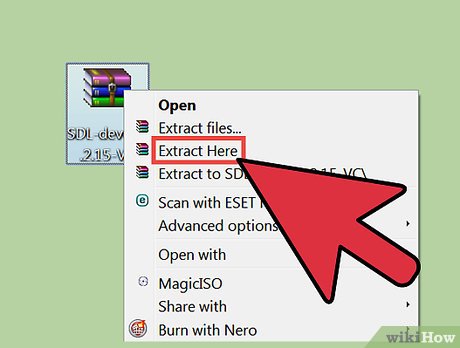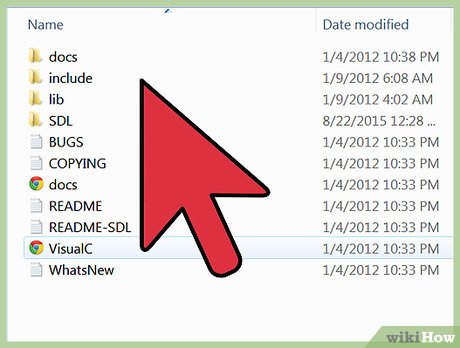How to Install and Configure Simple Directmedia Layer (SDL)
Method 1 of 3:
Download
-
 Downloading SDL from the official website. Follow this link to get directly to the download page.
Downloading SDL from the official website. Follow this link to get directly to the download page.- FIRST WARNING : You want to download the "DEVEL" (development) version of SDL, so scroll down the page to find it.
- Download a version that is compatible with your IDE. For example, you should download "SDL-devel-1.2.14-VC6.zip" for MS visual C++ express 2010.
- If you have a doubt about what version to get, ask in the discussion page.
Method 2 of 3:
Installation
-
 Unzip the .zip you just downloaded with "extract here."
Unzip the .zip you just downloaded with "extract here." -
 You should now have a folder called "SDL-{version number}". For example, "SDL-1.2.14" (the latest release as of 3 Jan. 2012).
You should now have a folder called "SDL-{version number}". For example, "SDL-1.2.14" (the latest release as of 3 Jan. 2012). -
 SPECIAL STEP don't skip it or you won't be able to make it work.:
SPECIAL STEP don't skip it or you won't be able to make it work.:- Go in "SDL-{version}/include/SDL". Copy all the files.
- Go back one step (so "SDL-{version/include}". Paste files. It IS important.
-
 Go back to "My downloads" or wherever you downloaded SDL.
Go back to "My downloads" or wherever you downloaded SDL. -
 Copy the whole "SDL-{version number}" folder you downloaded, somewhere on your computer, preferably next to the MINGW folder. Look at the picture below to see how it should look.
Copy the whole "SDL-{version number}" folder you downloaded, somewhere on your computer, preferably next to the MINGW folder. Look at the picture below to see how it should look. -
 You are now ready for the third and last step, configuration inside Code::Blocks.
You are now ready for the third and last step, configuration inside Code::Blocks.
Method 3 of 3:
Configuration in Code::Blocks
-
 Open Code::Blocks.
Open Code::Blocks. -
 Create a new project, scroll down and find "SDL project". Press "Go."
Create a new project, scroll down and find "SDL project". Press "Go." -
 Name your project as you wish and place it where you want, as long as you keep things tidy. Press "Next."
Name your project as you wish and place it where you want, as long as you keep things tidy. Press "Next." -
 Now is the critical step, Code::Blocks asks you where SDL devel libraries are. Let's tell it where it is.
Now is the critical step, Code::Blocks asks you where SDL devel libraries are. Let's tell it where it is.- You should see something like "${#sdl}" written as location. It means it searches for SDL inside the MINGW compiler. But to keep things tidy, we just copied the "SDL-{version}" folder, next to mingw. (See picture above.)
-
 Click the three dots "...", it will bring up a path selection screen. Select the copied folder from step 4.
Click the three dots "...", it will bring up a path selection screen. Select the copied folder from step 4.- In case you get the alternate screen, with "BASE", "include", "lib", etc..., just go to "BASE", select the path where you copied SDL, and click "Close", that's it! Nothing more is needed.
-
 Congratulations, you successfully installed SDL for Code::Blocks. You only have to configure and install once. So if you want to create another SDL project, you don't have to re-do all of this.
Congratulations, you successfully installed SDL for Code::Blocks. You only have to configure and install once. So if you want to create another SDL project, you don't have to re-do all of this.
4.5 ★ | 2 Vote
You should read it
- Admire the robot model can transform itself as Transformer
- How to use StopAd blocking ads on Windows
- Select blocks of text and manipulate blocks in Word
- Group in Word, group of image blocks in Word
- Google Chrome will block unsafe downloads on HTTPS websites
- It is possible to turn iPhone lock into an international version with only one piece of code, and this is a way to identify to avoid being tricked when buying an old iPhone
- What is Low-Code? And how does it work?
- Chrome 71 automatically blocks any annoying ads
May be interested
- How to install and configure MySQL server on Pi
 databases like mysql are often the primary component of dynamic web pages and one of the best ways to store data for web applications. mysql is a database management system that allows you to store and maintain large amounts of data with ease.
databases like mysql are often the primary component of dynamic web pages and one of the best ways to store data for web applications. mysql is a database management system that allows you to store and maintain large amounts of data with ease. - Internet: Transport layer protocols
 the transport layer in the dod reference model (see internet is really simple number 5/2003) provides the ability to communicate from one application program to another. in this section, we will look at two protocols in the transport layer: transport control protocol (tcp) and user datagram protocol (udp). all packets exchanged between computers on the network are thanks to one of the two protocols.
the transport layer in the dod reference model (see internet is really simple number 5/2003) provides the ability to communicate from one application program to another. in this section, we will look at two protocols in the transport layer: transport control protocol (tcp) and user datagram protocol (udp). all packets exchanged between computers on the network are thanks to one of the two protocols. - How to install an SSD for PC
 whether you want to install an ssd on a laptop or desktop, the process is quite simple. in today's article, tipsmake.com will read with readers how to install ssds for desktop.
whether you want to install an ssd on a laptop or desktop, the process is quite simple. in today's article, tipsmake.com will read with readers how to install ssds for desktop. - Install and configure email handling solutions on TMG 2010 Firewall - Part 2: E-Mail Policy
 in part 2 of the install and configure email handling solution on this tmg 2010 firewall, we will show you how to configure email protection policies.
in part 2 of the install and configure email handling solution on this tmg 2010 firewall, we will show you how to configure email protection policies. - Install 'sirens' for Windows with Predator
 therefore, improving information security has never been excessive. today, we will show you how to create another layer of security next to the security layer available on windows. with just a usb device and a software called predator, you can be assured of a 2-layer fence on your personal computer. let's see how to do it.
therefore, improving information security has never been excessive. today, we will show you how to create another layer of security next to the security layer available on windows. with just a usb device and a software called predator, you can be assured of a 2-layer fence on your personal computer. let's see how to do it. - How to Burn Dual Layer DVD
 a dual layer dvd (digital versatile disc) is similar to the original dvd created by efmplus in 1995 except it can store up to 8.5 gigabytes of data instead of just 4.7 gigabytes. since a dual layer dvd has a different storage capacity you...
a dual layer dvd (digital versatile disc) is similar to the original dvd created by efmplus in 1995 except it can store up to 8.5 gigabytes of data instead of just 4.7 gigabytes. since a dual layer dvd has a different storage capacity you... - How to install and configure backups in Windows Server 2012
 in this article, we will learn how to install and configure backups, which are not too different from previous versions.
in this article, we will learn how to install and configure backups, which are not too different from previous versions. - How to rotate a layer in Photoshop
 how to rotate a layer in photoshop. rotating the layer is a fairly basic operation in photoshop, it is similar to when we rotate an image. in this article, tipsmake.com will show you how to rotate a layer in photoshop, please follow along.
how to rotate a layer in photoshop. rotating the layer is a fairly basic operation in photoshop, it is similar to when we rotate an image. in this article, tipsmake.com will show you how to rotate a layer in photoshop, please follow along. - How to Make a Map Using Leaflet
 leaflet is an easy-to-use and fairly powerful javascript tool that enables us to create and display maps on a website. this article will guide you in setting up leaflet, and then building a simple map that has a tile layer from mapbox and...
leaflet is an easy-to-use and fairly powerful javascript tool that enables us to create and display maps on a website. this article will guide you in setting up leaflet, and then building a simple map that has a tile layer from mapbox and... - How to enable 2-layer authentication on Zalo
 zalo now provides 2-layer authentication feature on zalo, to increase the security of your personal account when logging into your zalo account on an unfamiliar device.
zalo now provides 2-layer authentication feature on zalo, to increase the security of your personal account when logging into your zalo account on an unfamiliar device.























 How to Make a Tartan Heart Image in Excel
How to Make a Tartan Heart Image in Excel How to Name Your App
How to Name Your App How to Program Computer Games
How to Program Computer Games How to Become a Full Stack Programmer
How to Become a Full Stack Programmer How to Code As a Kid
How to Code As a Kid How to Become a Programmer
How to Become a Programmer